Sprained Ankle
Information and exercise leaflet for
patient’s and carers
What is a Sprained Ankle?
A sprained ankle occurs when the foot is forcibly overstretched inwards or outwards. This causes damage to the tissues which have been overstretched. These tissues may become inflamed, sore and possibly bruised.
Ankle Rehabilitation – Early Stage
The early stage of rehabilitation is for use when the ankle is painful, swollen and possibly bruised. This is usually up to the first 10 days after injury, but it can be longer. Follow the PRICE method (Protection, Rest, Ice, Compression, and Elevation).
Protection- An elastic bandage, adhesive strapping or aircast splint may be provided if necessary by your Physiotherapist/Doctor. If you wish, a simple ankle support obtained from any good sports shop or chemist may be helpful at this stage.
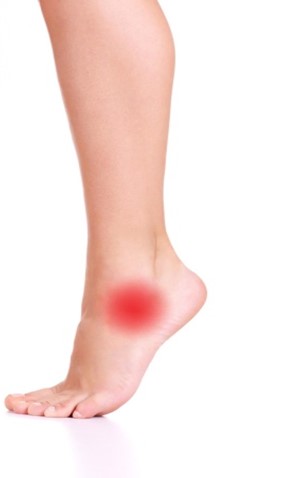
Rest - Some rest (Activity Modification) but not complete rest is usually advised. A walking aid may be a useful option to take some weight off the injured ankle as you mobilise. When you are walking, try to walk as normally as possible (e.g without a limp or pointing the foot outwards), as this helps tissues heal correctly.
Ice
- Use an ice pack (either ice cubes or a bag of frozen vegetables) placed in a moist towel.
- Apply the ice to the swollen area at least 3 times per day.
- Apply for 10-15 minutes. If the skin becomes uncomfortable, stop the treatment until it returns to normal.
- DO NOT apply if you have circulation problems or poor skin sensation.
Compression - Whilst the swelling remains, continue to wear your elasticated support / strapping. This will prevent further swelling and aid in swelling reduction.
Elevation - When resting, elevate your foot higher than your hip (with your whole leg supported). Avoid standing or sitting for long periods with your foot resting on the floor.
Painkillers - Consult your GP or local pharmacist for advice as to which medication is suitable for you to take, particularly if you are taking other medications or have other health issues.
Warning Signs
If you develop new or worsening symptoms, if you are unwell with the pain, or under the age of 16 years, seek medical advice.
The following symptoms are very rare, but if you suddenly develop any of them, you should seek urgent medical attention at your local Urgent Care Centre.
- Sudden onset of Achilles pain, with a “pop” or snapping sound/sensation.
- Inability to weight-bear through the foot/ankle.
- New significant injury to the leg/foot/ankle.
- Constant night pain in the foot/ankle (that prevents rest/sleep).
- Significant swelling, colour change or temperature change in the foot/ankle or extending up the leg.
- Lumps in the foot/ankle.
- Signs of infection i.e. night sweats that are out of the ordinary, high temperature and feeling unwell.
- Unexplained weight loss
If your symptoms fail to improve within 6-8 weeks with this regime you should contact your doctor for a physiotherapy referral.
If your symptoms improving (even slowly), continue for up to 3 months.
Exercises for Acute Ankle Pain
The exercises below are in order of difficulty. Start with the first and if this does not increase your symptoms progress to the next one.
Use the reaction rules to guide your exercise intensity. If pain is stopping you engaging in rehab, you should speak to your GP about pain relief promptly.
Flare-ups may happen - if it doesn’t settle in a couple of weeks, then seek further advice

Ball Control
Sit upright on a chair. Place a ball underneath your foot. Practice moving the ball in different directions. Start forwards and backwards, and then side to side. It is a good movement and control exercise for the ankle, especially after injury. If you do not have a ball, roll a water bottle under your foot.
Perform for 30 seconds forwards/backwards, then 30 seconds side/side.
Repeat 3 times 3 times daily
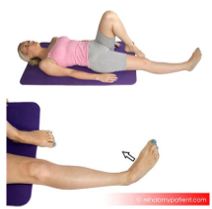
Ankle Inversion/Eversion
Lying flat on your back or sitting on the floor, move your foot inwards then outwards. Repeat the movement. This is a mobility exercise for the ankle.
Perform for 60 seconds Repeat 5 times 3 times daily
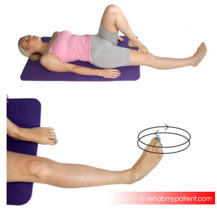
Ankle Circles
Lying on your back, move your ankles around in circles both anti-clockwise and clockwise. This is a great mobility exercise to the ankle, and very useful for ankle stiffness following a sprain.
Perform for 60 seconds Repeat 5 times 3 times daily
Level 2 – If exercies at level 1 feel easy to complete you can try the following exercises – ensure you have something to hold onto for balance and to prevent falls
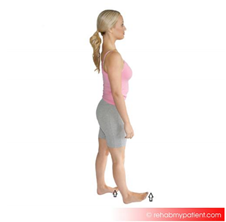
Heel Walking
Walk forwards on your heels. Start the exercise wearing trainers, and progress to bare feet as your feet get stronger. Use a wall to provide support if required. This is a great foot and ankle strengthening exercise and improves balance.
Perform for 60 seconds Repeat 5 times 3 times daily
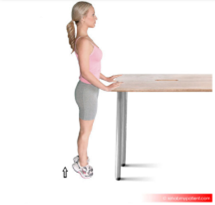
Calf Raises Two Legs
Stand upright and hold onto a wall/table for balance if required. Slowly raise up onto your toes and control the movement back down. This exercise will strengthen the calf muscles and ankle joints.
Perform 10 reps Repeat 5 times 3 times daily

Single leg stand
Stand on one leg and try to keep your balance. Be careful and hold on to a wall for support when you first start this exercise. A single leg balance exercise such as this is an enormously valuable exercise, and its benefits include strengthening the muscles and ligaments around the ankles and knees and improving balance.
Hold for 60 seconds Repeat 5 times 3 times daily
What actions can I take to improve my health?
Evidence tells us that making healthy lifestyle choices can have a big impact on influencing problems with your muscles and bones and can play a major role in your overall health. Some of the most effective areas to address are below: (click on the links).
Maintaining a healthy weight: www.nhs.uk/live-well/healthy-weight/
Increasing levels of physical activity: www.nhs.uk/live-well/exercise/
Avoiding poor sleep patterns: www.nhs.uk/live-well/sleep-and- tiredness/how-to-get-to-sleep/
Reducing alcohol consumption: www.nhs.uk/live-well/alcohol- support/calculating-alcohol-units/
Stopping smoking: www.nhs.uk/live-well/quit-smoking/
Maintaining a healthy mind: www.nhs.uk/conditions/stress-anxiety- depression/
The good news is that you are able to influence lots of these by modifying your lifestyle. Therefore it is important that you consider addressing these areas alongside your current treatment.
You may wish to discuss any of these factors with your treating clinician who will be able to work with you and guide your long-term management and support you to improve your wellbeing.
There will be information about the local services that exist within the waiting areas of the physiotherapy department and your treating clinician will be able to help signpost you to appropriate services.
The websites listed below give more information on local services available:
• Blackburn and Darwen - https://refreshbwd.com/
• East Lancashire - http://www.upandactive.co.uk/
• Public Health England https://www.gov.uk/government/organisations/public-health-england
Review Date: January 2024


